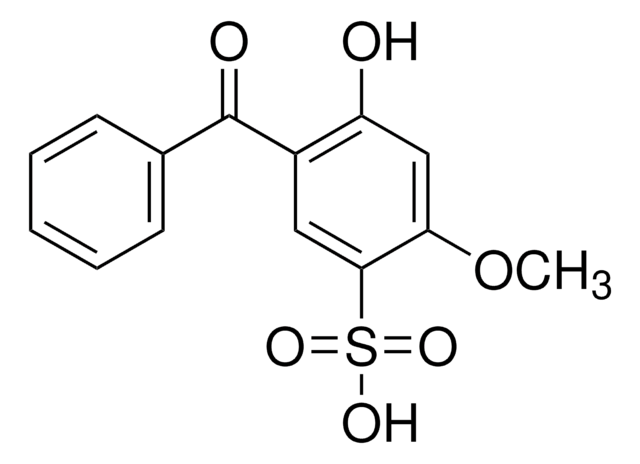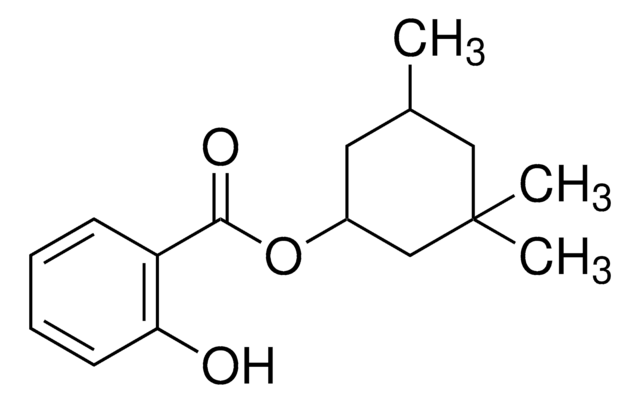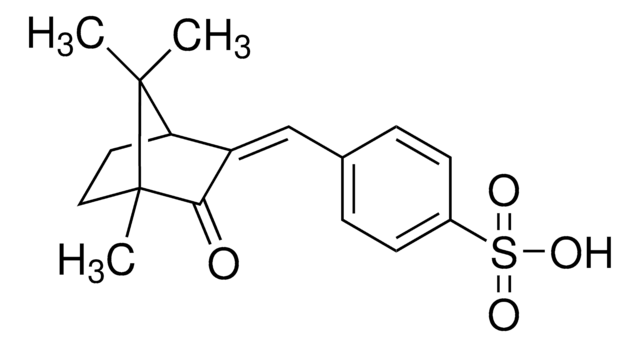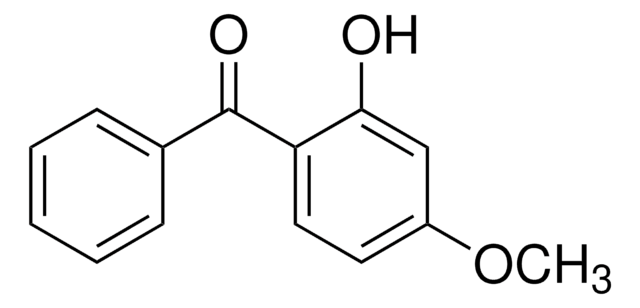437166
2-Phenyl-5-benzimidazolesulfonic acid
96%
Sinônimo(s):
Ensulizole
Faça loginpara ver os preços organizacionais e de contrato
About This Item
Fórmula empírica (Notação de Hill):
C13H10N2O3S
Número CAS:
Peso molecular:
274.30
Número MDL:
Código UNSPSC:
12352100
ID de substância PubChem:
NACRES:
NA.22
Produtos recomendados
Nível de qualidade
Ensaio
96%
pf
>300 °C (lit.)
solubilidade
ethanol and water: soluble (as sodium salt)
grupo funcional
phenyl
sulfonic acid
cadeia de caracteres SMILES
OS(=O)(=O)c1ccc2[nH]c(nc2c1)-c3ccccc3
InChI
1S/C13H10N2O3S/c16-19(17,18)10-6-7-11-12(8-10)15-13(14-11)9-4-2-1-3-5-9/h1-8H,(H,14,15)(H,16,17,18)
chave InChI
UVCJGUGAGLDPAA-UHFFFAOYSA-N
Procurando produtos similares? Visita Guia de comparação de produtos
Categorias relacionadas
Descrição geral
2-Phenyl-5-benzimidazolesulfonic acid has been reported as UV filter. It is a xenobiotic compound detected in in gray water from houses and effluents of the biological treatment systems (aerobic, anaerobic, and combined anaerobic+aerobic). It is a micropollutant of personal care products and its removal from aerobically treated grey water by ozonation and adsorption onto activated carbon has been reported.
Aplicação
2-Phenyl-5-benzimidazolesulfonic acid was used for the fabrication of biomimetic sensor for determination of 4-methylbenzylidene camphor (4-MBC), an ultraviolet (UV) radiation protector.
UV absorber
Código de classe de armazenamento
11 - Combustible Solids
Classe de risco de água (WGK)
WGK 1
Ponto de fulgor (°F)
Not applicable
Ponto de fulgor (°C)
Not applicable
Escolha uma das versões mais recentes:
Já possui este produto?
Encontre a documentação dos produtos que você adquiriu recentemente na biblioteca de documentos.
Os clientes também visualizaram
Lucía Hernández Leal et al.
Environmental science & technology, 44(17), 6835-6842 (2010-08-05)
Eighteen selected xenobiotics related to personal care and household chemicals (UV-filters, fragrances, preservatives, biocides, surfactants) were measured in gray water from 32 houses and in effluents of three different biological treatment systems (aerobic, anaerobic, and combined anaerobic+aerobic). All selected xenobiotics
Application of a biomimetic sensor based on iron phthalocyanine chloride: 4-methylbenzylidene-camphor detection.
Boni AC, et al.
Journal of the Brazilian Chemical Society, 21(7), 1377-1383 (2010)
L Hernández-Leal et al.
Water research, 45(9), 2887-2896 (2011-04-02)
Ozonation and adsorption onto activated carbon were tested for the removal micropollutants of personal care products from aerobically treated grey water. MilliQ water spiked with micropollutants (100-1600 μgL(-1)) was ozonated at a dosing rate of 1.22. In 45 min, this
Ashley R Heurung et al.
Dermatitis : contact, atopic, occupational, drug, 25(6), 289-326 (2014-11-11)
Sunscreen is a key component in the preventive measures recommended by dermatologists and public health campaigns aimed at reducing sunburn, early skin aging, and skin cancer. To maximize compliance, adverse reactions to sunscreens should be minimized. Although inactive ingredients cause
Murilo L Bello et al.
PloS one, 10(3), e0121110-e0121110 (2015-03-25)
Layered drug delivery carriers are current targets of nanotechnology studies since they are able to accommodate pharmacologically active substances and are effective at modulating drug release. Sodium montmorillonite (Na-MMT) is a clay that has suitable properties for developing new pharmaceutical
Nossa equipe de cientistas tem experiência em todas as áreas de pesquisa, incluindo Life Sciences, ciência de materiais, síntese química, cromatografia, química analítica e muitas outras.
Entre em contato com a assistência técnica










